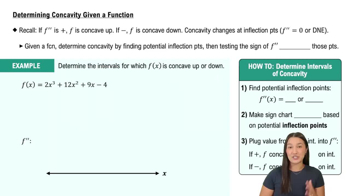Concavity Determine the intervals on which the following functions are concave up or concave down. Identify any inflection points.
h(t) = 2 + cos 2t on [0,π]
 Verified step by step guidance
Verified step by step guidance Verified video answer for a similar problem:
Verified video answer for a similar problem:



 6:38m
6:38mMaster Determining Concavity from the Graph of f with a bite sized video explanation from Patrick
Start learning